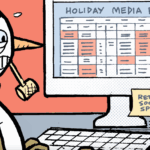 For many in the native space, the always-on-the-horizon prospect of the Promised Land has been a hard sell to other digital stakeholders. And though the industry has grown at a rapid clip, there’s still deep confusion over questions as basic and crucial as “What is native?”
For many in the native space, the always-on-the-horizon prospect of the Promised Land has been a hard sell to other digital stakeholders. And though the industry has grown at a rapid clip, there’s still deep confusion over questions as basic and crucial as “What is native?”
Native is “a broad term that lacks definition,” said Xaxis CEO Brian Gleason. Xaxis “classifies native as engagement,” he said, comparing it to interrupting someone in the middle of a cocktail party conversation, which could backfire if you don’t know the context.
Those who own the context – mobile social feeds like Facebook, Instagram, Twitter and Snapchat – have propelled the entire category. Native accounted for the majority of all US display ad revenue last year, and Business Insider predicted earlier this year that native would generate 74% of US display revenue by 2021.
Yet for all the promise, there remains a wide and differentiated landscape, rife with independent programmatic vendors and media- or publisher-sponsored content, all of which are stuck in a gray purgatory, waiting for the market and ecosystem to move along.
“I don’t think of it as ‘native’ so much as I do a channel for content marketing,” said Woody Meachum, group director of digital strategy at the Omnicom agency OMD. He called the term “a fancy word digital came up with for a print advertorial.”
Native channels outperform other display options and have devoured OMD’s display media share, Meachum said. That resulted in a skewed set of priorities.
Native tech supply vendors, such as heavily integrated incumbents TripleLift and Sharethrough, needed demand-side platforms (DSPs) to build brand solutions for native, but the brands were pushing harder for categories like video.
The native specialist vendors have in the past year moved from managed service to creating self-service platforms, “where they can be integrated into the primary DSP partners,” said Rachel Eckerling, director of programmatic at the Publicis agency Mediavest|Spark.
The thing holding the space back, Eckerling said, “is that depending on who you talk to – what vendor, what unit, what publisher – we’re still in a place where we haven’t formulated what native is and can be.”
The headaches of technical integrations across native suppliers and DSPs may seem separate from the lack of clarity around native in the market, but the two are intertwined
The Trade Desk was one of the major DSPs, alongside AppNexus, to integrate with TripleLift, Sharethrough and other native suppliers in the past year. But “we’re talking about only the in-feed native advertising,” said Tim Sims, The Trade Desk’s VP of inventory partnerships.
The IAB has six categories for native “and there’s a lot hiding underneath that umbrella, but [in-feed] is the only one it makes sense for us to support right now,” Sims said. “It’s challenging to support custom implementations across 10 or more suppliers or straight to publishers producing the native content, which don’t have their own RTB-enabled environment.”
But if that’s the vision of native inventory from DSPs – which would make sense since that’s where inventory is surging – it doesn’t mesh with how the supply side of the industry thinks about native.
Take the Daily Dot, which has built out its own in-house agency to pitch brands and produce sponsored content.
“I don’t think we ever really use the word ‘native,’ to be honest,” said Brian Dresher, VP of business development at the Daily Dot.
Instead, they call it what it is: branded content.
Native is the “only demand-constrained channel,” said Sharethrough founder and CEO Dan Greenberg. He expects brands (and DSPs) will follow the hard-earned examples of The Trade Desk and AppNexus, “since native is going to be far and away the largest net new inventory source.”
Will native finally achieve its promise or will it continue at its muddled pace?
“It’s far too early to tell, but we’re excited about the growth indicators,” Sims said of The Trade Desk’s first few months of native integration. “It seems like there will be a lot of demand ready to come through.”












